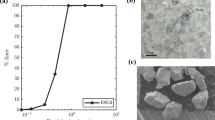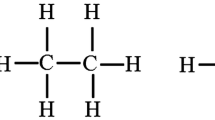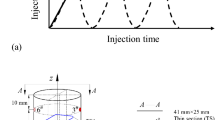Abstract
Polymer injection in hydrocarbon reservoirs has been of great interest in petroleum engineering as an enhanced oil recovery method. In order to have a reliable injection plan, an accurate estimation of polymer behaviour is required to control the fluid flow in porous media. However, it is difficult to calculate the flow properties of polymer solutions—known as non-Newtonian fluids—in porous media, due to variable viscosity at different shear rates. Adsorption of polymer molecules onto the rock surface decreases the available cross-sectional area of polymer solution, therefore at a constant rate, the shear rate increases. As a result, it is important to investigate how polymer adsorption can affect the polymer solution flow behaviour in porous media. Moreover, prior to any polymer injection plan, the amount of adsorbed polymer should be calculated, due to the high cost of polymers. In the present study, pore network modelling was used to investigate the effect of polymer adsorption on flow behaviour of polymer solutions in porous media. To achieve this goal, a simple pore was constructed to adequately represent the real structure of the porous medium. It was then validated by simulation of Newtonian fluid flow in the network and comparison of the calculated flow properties with the experimental data. After validation, the pore network was used for simulation of non-Newtonian fluid flow in porous media. The experimental apparent viscosity of non-Newtonian fluid was used for verification of the procedure and the developed network. The apparent viscosity of non-Newtonian was calculated successfully using macroscopic properties of the rock sample and measured bulk properties of non-Newtonian fluid. The effect of polymer adsorption on calculation of non-Newtonian fluid apparent viscosity was then investigated. It was shown that the polymer adsorption process plays an important role in calculation of polymer solution apparent viscosity. The results reveal that polymer adsorption cannot be neglected, especially in near well-bore areas where the adsorption is high. Finally, the effect of wettability in calculating the total amount of adsorbed polymer volume was studied. The results suggest that neglecting the rock’s wettability can result in an overestimation or underestimation of the amount of adsorbed polymer.












Similar content being viewed by others
Abbreviations
- \(\hbox {A}_{\mathrm{ow}}\) :
-
Oil-wet area \((\hbox {m}^{2})\)
- \(\hbox {A}_{\mathrm{ww}}\) :
-
Water-wet area \((\hbox {m}^{2})\)
- \(\hbox {AC}_{\mathrm{cat-ow}}\) :
-
Adsorption coefficient of cationic polymer on oil-wet surface \((\hbox {mg/m}^{2})\)
- \(\hbox {AC}_{\mathrm{cat-ww}}\) :
-
Adsorption coefficient of cationic polymer on water-wet surface \((\hbox {mg/m}^{2})\)
- C:
-
Consistency Index \((\hbox {Pa s}^{\mathrm{n}})\)
- \(\hbox {C}_{\mathrm{p}}\) :
-
Polymer concentration (ppm)
- f :
-
The fraction of mixed-wet pores and throats (fraction)
- \(\hbox {F}_{\mathrm{rr}}\) :
-
Permeability reduction factor (fraction)
- K:
-
Rock permeability (D)
- \(\hbox {K}_{\mathrm{w}}\) :
-
Permeability of rock before polymer treatment (md)
- \(\hbox {K}_{\mathrm{wp}}\) :
-
Permeability of rock after polymer treatment (md)
- L:
-
The length of circular capillary (m)
- n:
-
Shear-thinning exponent in Power Law model (dimensionless)
- \(\hbox {P}_{\mathrm{c}}\) :
-
Capillary pressure (Pa)
- \(\hbox {P}_{\mathrm{c,max}}\) :
-
Maximum capillary pressure reached during primary drainage (Pa)
- \(\hbox {P}_{\mathrm{c}}^*\) :
-
Threshold capillary pressure for water film collapse (Pa)
- \(\Delta \hbox {P}\) :
-
Pressure drop across circular capillary (Pa)
- \(\hbox {Q}_{\mathrm{N}}\) :
-
Newtonian fluid flow rate \((\hbox {m}^{3}\hbox {/s})\)
- \(\hbox {Q}_{\mathrm{NN}}\) :
-
Non-Newtonian fluid flow rate \((\hbox {m}^{3}\hbox {/s})\)
- r:
-
Radius of circular capillary (m)
- q:
-
Darcy velocity (m/s)
- \(\hbox {S}_{\mathrm{wi}}\) :
-
Irreducible water saturation (fraction)
- Z:
-
Average coordination number (dimensionless)
- \(\alpha \) :
-
Scaling factor for adjusting calculated apparent viscosity (1/m)
- ø:
-
Rock porosity (fraction)
- \({\sigma }\) :
-
Interfacial tension, IFT (mN/m)
- \(\mu _{\mathrm{app}}\) :
-
Apparent viscosity (Pa s)
- \(\mu _N\) :
-
Newtonian fluid viscosity (Pa s)
- \(\mu _{o}\) :
-
Oil viscosity (Pa s)
- \(\mu _{w}\) :
-
Water viscosity (Pa s)
- \(\mu _{0}\) :
-
Non-Newtonian fluid viscosity in lower Newtonian region (Pa s)
- \(\mu _\infty \) :
-
Non-Newtonian fluid viscosity in upper Newtonian region (Pa s)
- \(\dot{\gamma }\) :
-
Shear rate (1/s)
- \(\updelta \) :
-
Weibull distribution parameter
- \(\upomega \) :
-
Weibull distribution parameter
- \(\uptau _{\mathrm{rz}}\) :
-
Shear stress (Pa)
References
Al-Gharbi, M.S., Blunt, M.J.: A 2D Dynamic pore network model for modeling primary drainage. In: Proceedings of the ESF Workshop on Multiphase Flow in Porous Media, Delft (2003)
Bird, R.B., Stewart, W.E., Lightfoot, E.N.: Transport Phenomena. Wiley, Hoboken (2007)
Blunt, M.J.: Pore level modeling of the effects of wettability. SPE J. 2(04), 494–510 (1997)
Blunt, M.J.: Flow in porous media–pore-network models and multiphase flow. Curr. Opin. Coll. Interf. Sci 6(3), 197–207 (2001)
Blunt, M.J., Jackson, M.D., Piri, M., Valvatne, P.H.: Detailed physics, predictive capabilities and macroscopic consequences for pore-network models of multiphase flow. Adv. Water Res. 25(8), 1069–1089 (2002)
Cannella, W., Huh, C., Seright, R.: Prediction of xanthan rheology in porous media. SPE 18089, 2–5 (1988)
Carreau, P.J.: Rheological equations from molecular network theories. Trans. Soc. Rheol. (1957-1977) 16(1), 99–127 (1972)
Chauveteau, G.: Rodlike polymer solution flow through fine pores: influence of pore size on rheological behavior. J. Rheol. (1978-present) 26(2), 111–142 (1982)
Chauveteau, G., Zaitoun, A.: Basic rheological behavior of xanthan polysaccharide solutions in porous media: effects of pore size and polymer concentration. In: Proceedings of the First European Symposium on Enhanced Oil Recovery, Bournemouth, England, Society of Petroleum Engineers, Richardson, TX, pp. 197–212 (1981)
Chiappa, L., Mennella, A., Lockhart, T.P., Burrafato, G.: Polymer adsorption at the brine/rock interface: the role of electrostatic interactions and wettability. J. Petrol. Sci. Eng. 24(2), 113–122 (1999)
Cross, M.M.: Rheology of non-Newtonian fluids: a new flow equation for pseudoplastic systems. J. Coll. Sci. 20(5), 417–437 (1965)
De Waele, A.: Viscometry and plastometry. Oil Color Chem. Assoc. J. 6, 33–88 (1923)
Fletcher, A., Flew, S., Lamb, S., Lund, T., Bjornestad, E., Stavland, A., Gjovikli, N.: Measurements of polysaccharide polymer properties in porous media. In: SPE International Symposium on Oilfield Chemistry. Society of Petroleum Engineers (1991)
Green, D.W., Willhite, G.P.: Enhanced oil recovery. SPE Textbook Series, vol. 6. TX, USA (1998)
Hejri, S., Willhite, G.P., Green, D.W.: Development of correlations to predict biopolymer mobility in porous media. SPE Reserv. Eng. 6(01), 91–98 (1991)
Hirasaki, G.J., Pope, G.A.: Analysis of factors influencing mobility and adsorption in the flow of polymer solution through porous media. Soc. Petrol. Eng. J. 14(04), 337–346 (1974)
Kolodziej, E.J.: Transport mechanisms of xanthan biopolymer solutions in porous media, 1988/1/1 (1988)
Kovscek, A., Wong, H., Radke, C.: A pore-level scenario for the development of mixed wettability in oil reservoirs. AIChE J. 39(6), 1072–1085 (1993)
Lenormand, R., Zarcone, C., Sarr, A.: Mechanisms of the displacement of one fluid by another in a network of capillary ducts. J. Fluid Mech. 135, 337–353 (1983)
Lin, C., Cohen, M.: Quantitative methods for microgeometric modeling. J. Appl. Phys. 53(6), 4152–4165 (1982)
Lopez, X.: Pore-Scale Modelling of Non-Newtonian Flow. Imperial College, London (2004)
Lopez, X., Valvatne, P.H., Blunt, M.J.: Predictive network modeling of single-phase non-Newtonian flow in porous media. J. Coll. Interf. Sci. 264(1), 256–265 (2003)
Øren, P.-E., Bakke, S., Arntzen, O.J.: Extending predictive capabilities to network models. SPE J.- Richardson 3, 324–336 (1998)
Pearson, J., Tardy, P.: Models for flow of non-Newtonian and complex fluids through porous media. J. Non-Newtonian Fluid Mech. 102(2), 447–473 (2002)
Perrin, C.L., Tardy, P.M., Sorbie, K.S., Crawshaw, J.C.: Experimental and modeling study of Newtonian and non-Newtonian fluid flow in pore network micromodels. J. Coll. Interf. Sci. 295(2), 542–550 (2006)
Raoof, A., Hassanizadeh, S.M.: A new method for generating pore-network models of porous media. Transp. Porous Media 81(3), 391–407 (2010)
Savins, J.: Non-Newtonian flow through porous media. Indust. Eng. Chem. 61(10), 18–47 (1969)
Sorbie, K., Clifford, P., Jones, E.: The rheology of pseudoplastic fluids in porous media using network modeling. J. Coll. Interf. Sci. 130(2), 508–534 (1989)
Spanne, P., Thovert, J., Jacquin, C., Lindquist, W., Jones, K., Adler, P.: Synchrotron computed microtomography of porous media: topology and transports. Phys. Rev. Lett. 73(14), 2001 (1994)
Teeuw, D., Hesselink, F.T.: Power-law flow and hydrodynamic behaviour of biopolymer solutions in porous media. In: SPE Oilfield and Geothermal Chemistry Symposium. Society of Petroleum Engineers (1980)
Vogel, P., Pusch, G.: Some aspects of the injectivity of non-Newtonian fluids in porous media. In: Proceedings of the First European Symposium on EOR, Bournemouth, UK, pp. 21–22 (1981)
Yasuda, K., Armstrong, R., Cohen, R.: Shear flow properties of concentrated solutions of linear and star branched polystyrenes. Rheol. Acta 20(2), 163–178 (1981)
Author information
Authors and Affiliations
Corresponding author
Rights and permissions
About this article
Cite this article
Aghabozorgi, S., Rostami, B. An Investigation of Polymer Adsorption in Porous Media Using Pore Network Modelling. Transp Porous Med 115, 169–187 (2016). https://doi.org/10.1007/s11242-016-0760-5
Received:
Accepted:
Published:
Issue Date:
DOI: https://doi.org/10.1007/s11242-016-0760-5




